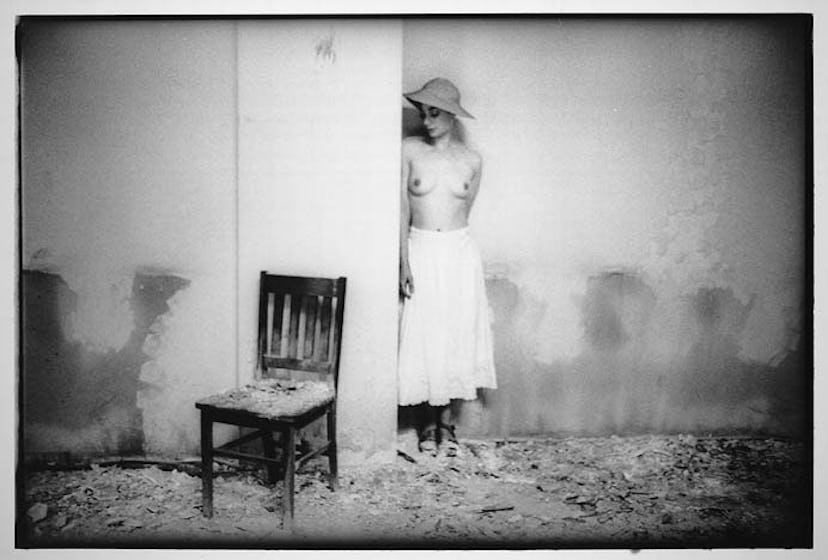Soft Focus
A new exhibition poses the question, did the artist Francesca Woodman really just want to be a fashion photographer?

Francesca Woodman is probably best remembered for photographs she made of herself in the nude. Small gems of surreal portraiture that transmit an erotic charge, they merged her body with surroundings that sometimes included snakes as bondage gear. She made most of them while still a student at the Rhode Island School of Design, graduating with every expectation of an exceptional career. Yet in 1981, at just 22, she took her own life. Now, with an exhibition of prints from a still-unfolding archive of thousands—most seeing the light of day for the first time—it turns out that her burning ambition was to photograph fashion.
Woodman made the 29 prints on view at the Marian Goodman Gallery in the last year of her life, several for friends from school who wanted to be fashion models. She was also hoping that the pictures she shot of herself would win her a job with the late Deborah Turbeville, with whom she shared a taste for dark moods and decrepit interiors. She did work for a few months as an assistant to the fashion photographer Marco Glaviano, but, says Lissa McClure, a director at Goodman, “Francesca was obsessed with Turbeville, because of her ability to do both commercial work and show in galleries. She got all dressed up to meet her, but Turbeville never showed, though we don’t know if she ever actually made an appointment.” In a notebook that Woodman made at the time, Turbeville’s name is penciled out.
From the photographs in the exhibition, on view through March 13, you can see from the jump that Woodman’s foray into fashion similarly took up where her art left off, but her pictures are leavened by humor. “I’m trying my hand at fashion photography,” she scrawled in red ink on one black-and-white image, where a brunette in a shapeless white dress stands in front of a wrinkled sheet unevenly tacked to a wall—Woodman’s version of seamless paper—the model’s hands covering her eyes in horror. In another picture, uncharacteristically shot on location, and at night, a model tries (and comically fails) to look provocative while snuggling up to one of the stone lions before the New York Public Library. Woodman shot another model cavorting with taxidermy animals at the Museum of Natural History, but made the others in her East Village walkup.
She was certainly her own best model. In one of the few color prints in the show, we see her reflection in a mirror propped against a wall of what appears to be an abandoned apartment. The mirror is its only décor, if you don’t count the peeling paint and the bits of fallen plaster scattered on the floor. Woodman stands behind her tripod in open-toed heels, her elegant hands cupped around the viewfinder of her camera. Her face is above the frame of the picture, but we see her body, clad in a prim, green wool dress with a long pleated skirt. In another shot, a model in the same dress is clinging to a doorpost, her feet well above the floor and her face obscured by auburn hair that is a near-match with the painted molding. In another photos, she’s holding up a packing blanket, with the words, “Maybe this is fashion,” scribbled across the bottom edge. In others, she’s enveloped in a cloud of feather boas.
Woodman’s sense of style was acute but it had less to do with the fashion of early 80’s than her taste for déclassé patterned dresses and petticoats that she picked up from frequent trips to second-hand shops. The green dress may be one that her mother, the painter and ceramicist Betty Woodman, bought for her to wear to a job interview, possibly the one she wanted with Turbeville. “Francesca was interested in style probably from age three,” says her mother, whose husband George Woodman is also an artist. “We were living in Italy when she was in second grade, and public school children had to wear a cotton coat over their clothes. It was blue with a white collar. And she said, ‘It’s a good thing I have to wear this, so people won’t see how awful the clothes are that you buy for me.’”
Woodman’s pictures do scream fashion, at least to our eyes today. In 1981, they must have looked like strange parodies of self-portraiture. Clothing may have been her subject, and her passion, but it’s the images themselves that are most striking. They’re too self-assured to be experiments, even if they were. In fact, they still look radical.
Francesca Woodman’s“I’m trying my hand at fashion photography” is on view through March 13th at Marian Goodman Gallery, 24 West 57th Street.
Photos: Soft Focus
I’m trying my hand at fashion photography, Providence, Rhode Island (P.076.5), 1977. Courtesy of the artist and Marian Goodman, New York.
Untitled, New York (NF.403), 1979-1980. Courtesy of the artist and Marian Goodman, New York.
Untitled, New York (NF.413), 1979-1980. Courtesy of the artist and Marian Goodman, New York.
Untitled, Providence, Rhode Island (P/NF.400), 1978. Courtesy of the artist and Marian Goodman, New York.
Untitled, New York (NF.4064), 1979-1980. Courtesy of the artist and Marian Goodman, New York.
Untitled, New York (NF.415), 1979-1980. Courtesy of the artist and Marian Goodman, New York.
This photograph is more fashion than that one, New York (N.384), 1979-1980. Courtesy of the artist and Marian Goodman, New York.
Untitled, New York, (N.407), 1979. Courtesy of the artist and Marian Goodman, New York.
Untitled, Providence, Rhode Island (P/NF.394), 1978. Courtesy of the artist and Marian Goodman, New York.
Another almost square fashion photograph, Providence, Rhode Island (P.066), 1975-1978. Courtesy of the artist and Marian Goodman, New York.
Untitled, New York (NF.464), 1979-1980. Courtesy of the artist and Marian Goodman, New York.
Untitled, Italy (I.190B), 1977-1978. Courtesy of the artist and Marian Goodman, New York.